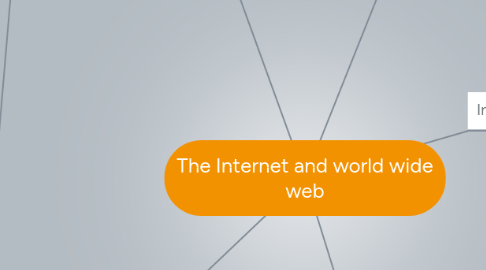
1. World wide web
1.1. The World Wide Web, or Web, consists of a worldwide collection of electronic documents (Web pages)
1.2. A Web siteis a collection of related Web pages and associated items
1.3. A Web serveris a computer that delivers requested Web pages to your computer
1.4. Web 2.0refers to Web sites that provide a means for users to interact
1.5. A home page is the first page that a Web site displays
1.6. Web pages provide linksto other related Web pages –Surfing the Web
1.7. Downloadingis the process of receiving information
1.8. Some Web pages are designed specifically for microbrowsers
1.9. A Web page has a unique address called a URLor Web address
1.10. Tabbed browsingallows you to open and view multiple Web pages in a single Web browser window
1.11. Two types of search tools are search engines and subject directories
1.11.1. Search engine
1.11.1.1. Images
1.11.1.2. Videos
1.11.1.3. Audio
1.11.1.4. News
1.11.1.5. NewsMaps
1.11.1.6. Businesses
1.11.1.7. Blogs
1.11.2. Subject directory
1.12. Multimediarefers to any application that combines text
1.12.1. Graphics
1.12.1.1. A graphicis a digital representation of nontextinformation
1.12.1.2. Graphic formats include BMP, GIF, JPEG, PNG, and TIFF
1.12.1.3. A thumbnail is a small version of a larger graphic
1.12.2. Audio
1.12.2.1. Audioincludes music, speech, or any other sound –Compressed to reduce file size
1.12.2.2. You listen to audio on your computer using a player
1.12.3. Video
1.12.3.1. Videoconsists of full‐motion images that are played back at various speeds
1.12.4. Animation
1.12.4.1. Animationis the appearance of motion created by displaying a series of still images in sequence
1.12.5. Virtual Reality
1.12.5.1. Virtual reality(VR) is the use of computers to simulate a real or imagined environment that appears as a three‐dimensional space
2. Other Internet Services
2.1. E‐mailis the transmission of messages and files via a computer network
2.1.1. An e‐mail programallows you to create, send, receive, forward, store, print, and delete e‐mail messages
2.1.2. A mailing listis a group of e‐mail names and addresses given a single name
2.1.2.1. Subscribingadds your e‐mail name and address
2.1.2.2. Unsubscribingremoves your name
2.2. Instant messaging (IM) is a real‐timeInternet communications service
2.3. A chatis a real‐time typed conversation that takes place on a computer
2.3.1. A chat roomis a location on an Internet server that permits users to chat with each other
2.4. VoIP(Voice over IP) enables users to speak to other users over the Internet –Also called Internet telephony
3. Internet
3.1. Evolution of The Internet
3.1.1. The Internet originated as ARPANET in September1969 and had two main goals
3.1.2. Each organization is responsible only for maintaining its own network -The World Wide Web Consortium (W3C) oversees research and sets guidelines and standards
3.1.3. Internet2 connects more than 200 universities and 115 companies via a high‐speed private network
3.1.4. Many home and small business users connect to the Internet via high‐speed broadband Internet service
3.1.5. An access provideris a business that provides individuals and organizations access to the Internet free or for a fee
3.1.6. ISP(Internetserviceprovider)
3.1.7. Online service provider (OSP)
3.1.8. Wireless Internet service provider (WISP)
3.1.9. An IP addressis a number that uniquely identifies each computer or device connected to the Internet
3.1.10. A domain nameis the text version of an IP address –Top‐level domain (TLD)
3.1.11. A DNS servertranslates the domain name into its associated IP address
